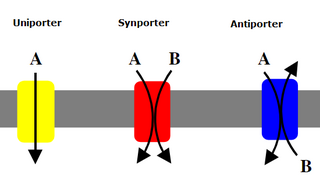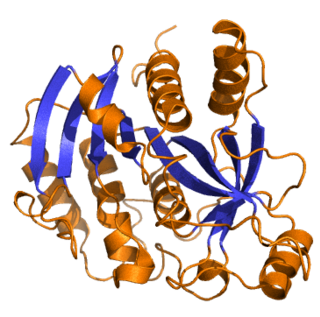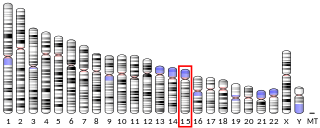Related Research Articles

Xanthine is a purine base found in most human body tissues and fluids, as well as in other organisms. Several stimulants are derived from xanthine, including caffeine, theophylline, and theobromine.

Uniporters, also known as solute carriers or facilitated transporters, are a type of membrane transport protein that passively transports solutes across a cell membrane. It uses facilitated diffusion for the movement of solutes down their concentration gradient from an area of high concentration to an area of low concentration. Unlike active transport, it does not require energy in the form of ATP to function. Uniporters are specialized to carry one specific ion or molecule and can be categorized as either channels or carriers. Facilitated diffusion may occur through three mechanisms: uniport, symport, or antiport. The difference between each mechanism depends on the direction of transport, in which uniport is the only transport not coupled to the transport of another solute.

The dopamine transporter is a membrane-spanning protein coded for in humans by the SLC6A3 gene, that pumps the neurotransmitter dopamine out of the synaptic cleft back into cytosol. In the cytosol, other transporters sequester the dopamine into vesicles for storage and later release. Dopamine reuptake via DAT provides the primary mechanism through which dopamine is cleared from synapses, although there may be an exception in the prefrontal cortex, where evidence points to a possibly larger role of the norepinephrine transporter.

Nucleoside analogues are structural analogues of a nucleoside, which normally contain a nucleobase and a sugar. Nucleotide analogues are analogues of a nucleotide, which normally has one to three phosphates linked to a nucleoside. Both types of compounds can deviate from what they mimick in a number of ways, as changes can be made to any of the constituent parts. They are related to nucleic acid analogues.
The Transporter Classification Database is an International Union of Biochemistry and Molecular Biology (IUBMB)-approved classification system for membrane transport proteins, including ion channels.

Purine nucleoside phosphorylase, PNP, PNPase or inosine phosphorylase is an enzyme that in humans is encoded by the NP gene. It catalyzes the chemical reaction

Trifluridine is an anti-herpesvirus antiviral drug, used primarily as prescription eyedrops. It was sold under the trade name Viroptic by Glaxo Wellcome, now merged into GlaxoSmithKline. The brand is now wholly owned by King Pharmaceuticals.
Neurotransmitter transporters are a class of membrane transport proteins that span the cellular membranes of neurons. Their primary function is to carry neurotransmitters across these membranes and to direct their further transport to specific intracellular locations. There are more than twenty types of neurotransmitter transporters.

Equilibrative nucleoside transporter 1 (ENT1) is a protein that in humans is encoded by the SLC29A1 gene. Multiple alternatively spliced variants, encoding the same protein, have been found for this gene. Expressed on red blood cell surfaces, these variants make up the Augustine blood group system.

The adenosine A2B receptor, also known as ADORA2B, is a G-protein coupled adenosine receptor, and also denotes the human adenosine A2b receptor gene which encodes it.

Equilibrative nucleoside transporter 2 (ENT2) is a protein that in humans is encoded by the SLC29A2 gene.

Concentrative nucleoside transporter 2 (CNT2) is a protein that in humans is encoded by the SLC28A2 gene.

Concentrative nucleoside transporter 1 (CNT1) is a protein that in humans is encoded by the SLC28A1 gene.

Reuptake inhibitors (RIs) are a type of reuptake modulators. It is a drug that inhibits the plasmalemmal transporter-mediated reuptake of a neurotransmitter from the synapse into the pre-synaptic neuron. This leads to an increase in extracellular concentrations of the neurotransmitter and an increase in neurotransmission. Various drugs exert their psychological and physiological effects through reuptake inhibition, including many antidepressants and psychostimulants.

An adenosine reuptake inhibitor (AdoRI) is a type of drug which acts as a reuptake inhibitor for the purine nucleoside and neurotransmitter adenosine by blocking the action of one or more of the equilibrative nucleoside transporters (ENTs). This in turn leads to increased extracellular concentrations of adenosine and therefore an increase in adenosinergic neurotransmission.

The plasma membrane monoamine transporter (PMAT) is a low-affinity monoamine transporter protein which in humans is encoded by the SLC29A4 gene. It is known alternatively as the human equilibrative nucleoside transporter-4 (hENT4). It was discovered in 2004 and has been identified as a potential alternate target for treating various conditions.

Nucleoside transporters (NTs) are a group of membrane transport proteins which transport nucleoside substrates like adenosine across the membranes of cells and/or vesicles. There are two known types of nucleoside transporters, concentrative nucleoside transporters and equilibrative nucleoside transporters, as well as possibly a yet-unidentified vesicular transporter.
Human concentrative nucleoside transporters include SLC28A1, SLC28A2 and SLC28A3 proteins. SLC28A2 is a purine-specific Na+-nucleoside cotransporter localised to the bile canalicular membrane. SLC28A1 is a Na+-dependent nucleoside transporter selective for pyrimidine nucleosides and adenosine. It also transports the anti-viral nucleoside analogues Zidovudine and Zalcitabine.

H syndrome, also known as Histiocytosis-lymphadenopathy plus syndrome or PHID, is a rare genetic condition caused by mutations in the SLC29A3 gene which encode the human equilibrative nucleoside transporter (hENT3) protein.
The Augustine blood group system is a human blood group system. It includes four red blood cell surface glycoprotein antigens which are encoded by alleles of the gene SLC29A1.
References
- ↑ Young, J. D.; Yao, S. Y. M.; Sun, L.; Cass, C. E.; Baldwin, S. A. (2008-07-01). "Human equilibrative nucleoside transporter (ENT) family of nucleoside and nucleobase transporter proteins". Xenobiotica. 38 (7–8): 995–1021. doi:10.1080/00498250801927427. ISSN 1366-5928. PMID 18668437. S2CID 86822179.
- 1 2 Baldwin SA, Beal PR, Yao SY, King AE, Cass CE, Young JD (Feb 2004). "The equilibrative nucleoside transporter family, SLC29". Pflügers Archiv. 447 (5): 735–43. doi:10.1007/s00424-003-1103-2. PMID 12838422. S2CID 8817821.
- 1 2 Molina-Arcas M, Casado FJ, Pastor-Anglada M (Oct 2009). "Nucleoside transporter proteins". Current Vascular Pharmacology. 7 (4): 426–34. CiteSeerX 10.1.1.319.2647 . doi:10.2174/157016109789043892. PMID 19485885. Archived from the original on 2013-01-13.
{{cite journal}}: CS1 maint: unfit URL (link) - ↑ Noji T, Karasawa A, Kusaka H (Jul 2004). "Adenosine uptake inhibitors". European Journal of Pharmacology. 495 (1): 1–16. doi:10.1016/j.ejphar.2004.05.003. PMID 15219815.
- ↑ Engel, Karen; Zhou, Mingyan; Wang, Joanne (2004-11-26). "Identification and characterization of a novel monoamine transporter in the human brain". The Journal of Biological Chemistry. 279 (48): 50042–50049. doi: 10.1074/jbc.M407913200 . ISSN 0021-9258. PMID 15448143.
- ↑ Griffiths, Mark (15 Dec 1997). "Molecular cloning and characterization of a nitrobenzylthioinosine-insensitive (ei) equilibrative nucleoside transporter from human placenta". Biochemical Journal. 328 (3): 739–43. doi:10.1042/bj3280739. PMC 1218980 . PMID 9396714.
- ↑ Orlandi, A.; Calegari, M. A.; Martini, M.; Cocomazzi, A.; Bagalà, C.; Indellicati, G.; Zurlo, V.; Basso, M.; Cassano, A. (2016-10-01). "Gemcitabine versus FOLFIRINOX in patients with advanced pancreatic adenocarcinoma hENT1-positive: everything was not too bad back when everything seemed worse". Clinical & Translational Oncology. 18 (10): 988–995. doi:10.1007/s12094-015-1471-z. ISSN 1699-3055. PMID 26742940. S2CID 9451723.
As of this edit, this article uses content from [PASTE TCDB URL HERE "PASTE TCDB ARTICLE TITLE HERE"], which is licensed in a way that permits reuse under the Creative Commons Attribution-ShareAlike 3.0 Unported License, but not under the GFDL. All relevant terms must be followed.